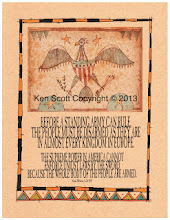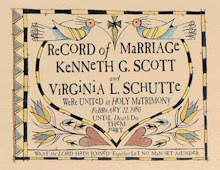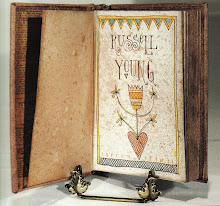The Artist as Intermediary:
SWAYING "SHAMS & GRINNING COCOONS"
SWAYING "SHAMS & GRINNING COCOONS"
“My transformational figures represent a world
when the animal was on a spiritual level and conversed with man.
These figures represent animals that were the original healers, wisdom seekers
and prophets from which early man sought his supernatural power.
(Ken Scott. “Artist statement.” Dated March 30, 2006)
craftsmanship; his thoughtful choice of materials, juxtaposed to maximize tactile and rhythmic effect, these are all secondary to the overall impression evoked by the sculptures. Most central to these works, is what the artist wishes for them to reveal about the non-physical; the realm of the intuitive and spiritual. The iconographic language of these images, convey the artist’s concerns and complex artistic purpose; i.e., to provoke consideration of such concepts as impermanence and transformation, and the fearsome power of the intuitive-spiritual idea. The works are metaphors for the realm of the intuitive – a way of sensing the true nature of reality; a thing lying beyond the senses; beyond the intellectual; a wisdom which has in large measure become lost and forgotten, in today’s world of concrete materialism and rational thinking.
This family of sculptures is intensely personal, even autobiographical. They are conceived and resonate from out of the place where a number of important influences come together: Scott’s early childhood experiences with the supernatural; his life as an artist; his reverence for history; and his strong faith as a Christian. They reflect personal complexity and contradiction; a sensibility functioning at more or less deeper levels of intensity, and far removed from the intellectual and rational. They are an exploration of the problem of what constitutes a wholeness in the spiritual dimension, and of what can both convey this content and constitute a wholeness in art. Implicit in this direction, is the idea of the artist as intermediary and the art object as medium, the conveyor of the artistic vision and catalyst for new insight.
Scott’s historical references, embodied in the iconography of these works, bring history to life in new ways. This is accomplished in his own unique way of ruthlessly mixing concepts; visual language, and symbolism from diverse historical periods, cultures, and religions. His varied formal language; sensitive layering of materials; and economy of touch, results in the creation of highly evocative effects. The passage of time and the artist’s hand have transformed every element used in these pieces. The artistic style in which these works are rendered, is characterized by strong use of rhythm and a limited and largely tonal color scheme. The artists concern with duality and process (natural processes of the physical world; the artistic processes; and the constantly flowing ever changing process of the self that feels and intuits) pervades these works, expressed in terms of dilapidation and death; transformation and regeneration; dark and beautiful, compelling and disturbing; at once captivating and offensive. These pieces of life and death; relics; mementoes of something that is past and beyond use in a conventional sense, gain new life in these works. Such sculptural allegories offer a new vital iconography for a new age of transcendent thought. They are modern symbols of myth and religion harking back to primitive tribal healing, spirits and the unseen forces said to underlie and overlie creation, constituting a wholeness and imparting new meaning to existence. The journey of the soul may be a dark and awful one (no radiant Christian spirituality here) but transformation, even regeneration, is inevitable; whether through faith in the redemptive power of the Christ or immersion of the self in the realm of the subjective/intuitive with its own kind of transforming wisdom and insight. Both paths to the spiritual realm are valid and interwoven, literally and metaphorically, under the artist’s hand. These dark, fractured, and romantic beings, are held together by memory and imagination – much like ourselves. Scott’s found objects have been transformed by artistic concept, into a new reality, or perhaps a new evocation of an old latent, forgotten reality, which slumbers but never sleeps. They are images which evoke a new, and terrible kind of beauty. They are beings from a world beyond the physical senses. The figures are wrapped, bound and nailed to their supports, suggesting that only artistic devices can secure and present such beings; well, perhaps just temporarily (an uncomfortable thought), as if their terrible vitality and spirituality could really be restrained by devices of any kind.
Scott’s visual language offers an interesting study in tensions, held in balance by the artistic idea. This equipoise heightens dramatic effect. There is tension between the art object and the viewer, a result of contrast posed by the beauty of the artist’s craftsmanship and the rather dreadful aspects of the figures as a whole. The beauty of Scott’s surfaces and details invites closer inspection, but the repellent aspect of some of the more nightmarish figures, makes one reluctant to lean in too closely! There is also a dichotomy posed between the concrete and beautifully crafted, and the abstract and transcendent nature of the artistic content. Historical tension likewise exists between the Christian and native indigenous animist iconographic language; and in the larger asymmetrical sculptures, there is tension between the utter reduction of the form to its skeletal structure, together with the overall tonalist palette, and the rich reatment of surface, in terms of texture and detail.
Another dominant stylistic element, is the artist’s use of line and texture, and layering to great rhythmic effect. One can almost hear the drums beating in the background. The artist uses rhythm to draw the viewer into the piece and then leads the eye through the composition. The limited tonal color scheme of taupes and browns, accented by dark blood red, heightens the rhythmic effect and furthers the artistic purpose. Out of the silence speaks the language of soul, conveyed in terms of rhythm.
Within the context of this genre of Scott’s works are two sub-groups which, to this writer’s mind, display the range of Scott’s artistic explorations in this direction thus far, and which taken together, constitute a wholeness. They are all strong, virile pieces. The large open-form, swaying, bird-like “shamans” stand in marked contrast to the self-contained and playfully rendered “cocoons.” The skulls and dressings of the figures are stained medium to dark brown in washes of color, as if stained by the grime of weather, or perhaps war. All formal elements are recycled fragments from life, which once formed a part of something else, animate and inanimate. All bear the telltale signs of having undergone some transformative process, whether natural or artistic. The mounts of the sculptures are also salvaged pieces.
The first discrete group are the “shamans.” They are asymmetrical and cruciform in shape. The asymmetry of their postures reinforces the sense of movement and rhythm, and creates a unusual, precarious feeling of balance. As a result the shamans seem to float and sway. They are stylized by a strong rhythmic use of line and texture, which lead the viewer’s eyes over the pieces and appeal to the viewers rhythmic sense. The handling of the figures’ drapery, wrappings and alternating, patterns formed by the materials used (raw silk, leather, bead and feather work) enliven the surface, unify the composition and contribute to the glittering sense of movement, particularly when seen by candle light, after dusk. The artists’s use of tonal contrast and the tactile sense of materials thus used, in rhythmic combinations, draw one into the world of the supernatural, like an incantation, unintelligible at first, but somehow both ominous, auspicious and full of meaning on some deeper cognitive level. As one considers these works, one can almost hear the drum beats in the background– the deeper , darker and lighter tones. These vital pieces resonate, engage and draw the viewer into them, for all their stark imagery of bone and bared teeth.
The large shaman is composed of simple formal elements, which bear the various telltale signs of the aging and deteriorating nature, of all things material. The fragment of skull, used here, once belonged to a deer. The base, is a composite construction, the elements of which could have come from a salvage yard. It was once painted with violet paint, which has since become brittle and has flaked away in patches. Upon the flat base is a worm eaten element, once part of a porch or a lantern. The figure’s undergarment of blood red velvet, wraps the figure down to the wooden base and covers the figure as high up, as where the chin might have been. Tinted raw silk linen wraps the figure overall. The discolorations of the outer linen wrapping, make the figure appear as though it had passed over many types of terrain in the worst kind of weather, for a long, long time. Leather binds the figure at the waist. A hawk’s feather, greasy and matted hangs suspended from the belt. Necklaces are worn about the neck. One is composed of two strands of red and black beads, flecked with a floral motif. The other, the shortest of the three necklaces, consists of a leather strip, from which is suspended an animals paw, the claws splayed – an amulet perhaps.
Another shaman of medium size, has a particularly predatory aspect, in contrast to the larger work, which seems somewhat more benign in appearance. A fragment of a coyote skull is used for the smaller shaman’s head. The eye sockets which have been darkened by a reddish brown stain, are empty and unsettling to peer into. The teeth are bared . The figure seems both remote and dangerous. The nose comes at the viewer like a weapon. The snout is wound about with twine. The back and chest are drawn up and thrust out, as if the figure were about to speak, wail or emit some sort of other-worldly, unimaginable sound. The “arms” form an S-curve beneath the frayed poncho. This figure embodies a great deal of movement. The overall effect is that of swaying spiral, moving side to side, forward and backward, in and out. When viewed as a group, of two or more, the shaman figures seem to perform a mysterious ritualized dance. As one moves around the figures to take in all aspects, they seem to change and move, and engage us as well, in a kind of unfathomable, timeless event, expressed through silent slow, meditative dance; the figures’ postures, gestures and “movements” coming out of some sacred, awful, soul-inspired place.
Scott’s sense of humor and playfulness inform all his pieces in some way, contributing to the sense of drama. In the asymmetrical figures, there is tension between the overall dark and forbidding aspect of the figures and the rich and playful use of detail. In the smaller “cocoons,” Scott’s touches of dark humor and irony lighten the heart. Art, of course, need not be entertaining, but particularly his “cocoons,”are. At once a bit shocking and darkly humorous, they are profound on one level, and diverting and amusing on another. These self-contained, symmetrical figures are smaller in scale than his larger cruciform pieces. The “cocoons,” aretightly wrapped little beings; with stocky, springy, rounded, child-like forms. They evoke thefeeling that a kind of wild, uncertain, mischievous vitality is contained within. Transformation, of course, and the question of “what will these creatures become when they break through their
wrappings?” is central to the cocoons. These funny, mysterious, and alarming little things, certainly need watching . . . even as they seem to watch us !
One small floating horizontal figure, strongly reminiscent of the mummified animals placed in ancient Egyptian tombs, is representative of this genre, of Scott’s transformation work. The figure is wrapped in strips of Scott’s signature, stained silk linen. The form is entirely
encapsulated in wrapping, just the “nose” and fanged upper jaw of the animal skull remains exposed. The grinning mouth, the only unwrapped feature, lends the figure a menacing and mischievous aspect. Another one of the cocoons is the “baby bear,” tightly wrapped in darkened linen, like the floating mini mummy, also, with just the fanged upper jaw exposed. The support is a weathered piece of wood, some architectural base of some kind, with paint surface peeling. The bear is seated firmly on his bottom; his chubby legs akimbo. It’s plump little arms open wide for an embrace– like a child that wants to be picked up– or perhaps the open gesture of the arms, is an invitation to join him in his game -- an intriguing thought. He wears a necklace of seven beads; four of them are fashioned in the shape of human skulls. Separating the little skulls are blue black beads of glass. The bear also seems to be playing with human skull shaped beads. He has neatly lined them up in front of him; the empty eye-sockets of the small skulls are turned outward toward the viewer. The bear has lifted his face away from his beads towards us, as if we have just disturbed and interrupted him at his play. He seems to regard us, his empty eye -sockets fix upon us, and he seems to laugh; as if heartily pleased with his efforts and the irony and humor of the whole situation.
With such a versatile artist as Ken Scott, one can never be sure where his fertile mind will next take him, but I for one, am expectantly looking forward to the next “generation” of transformation beings.

















